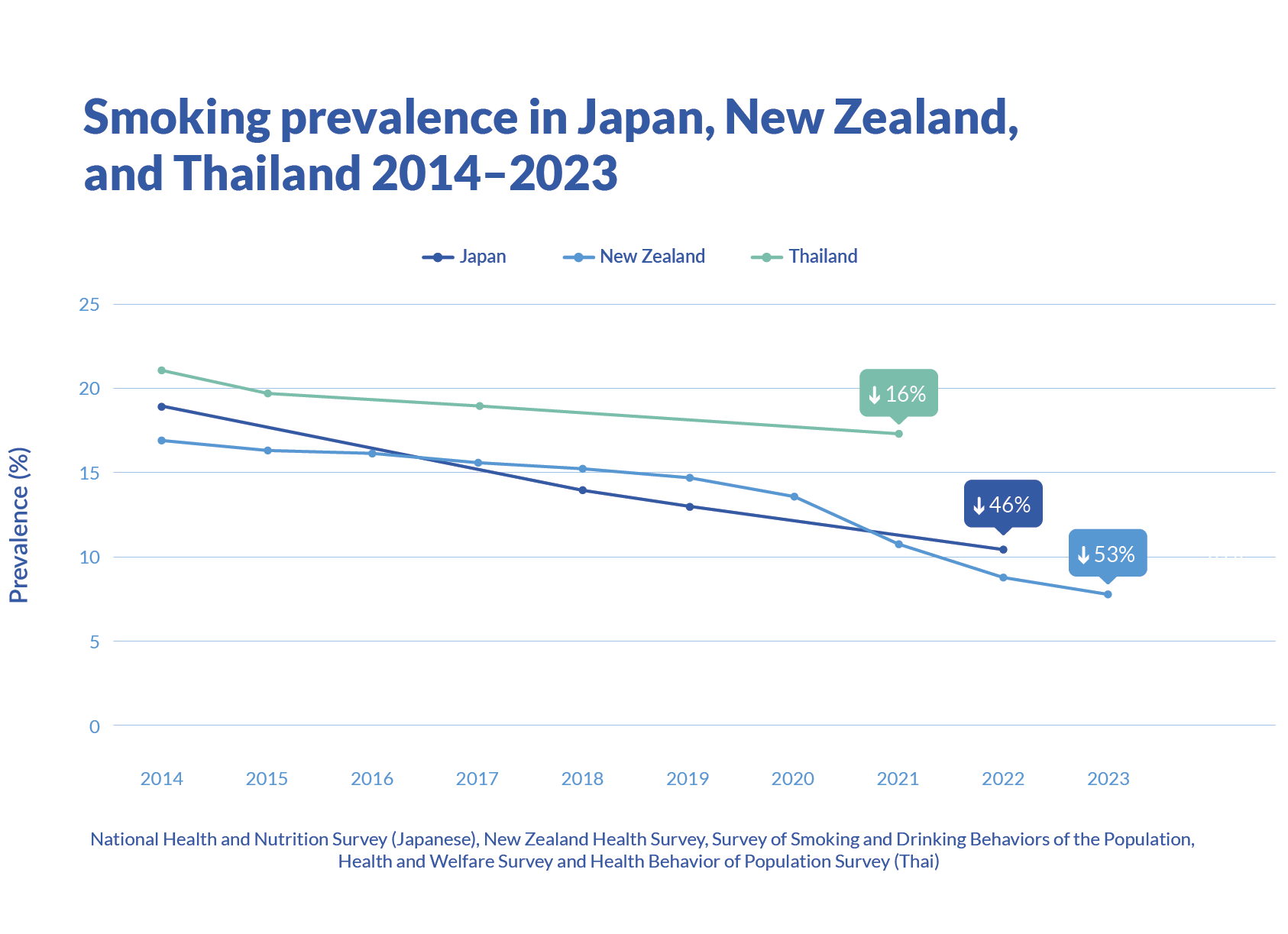Japan and New Zealand have taken a significantly more progressive approach toward smoke-free alternatives than Thailand—and the subsequent reduction in the numbers of adult smokers contrasts even more starkly over the past decade.
Whilst Thailand banned all smoke-free alternatives in 2014, effectively giving adults that don’t quit no choice but to continue smoking cigarettes or turn to illicit markets, Japan and New Zealand have given their smokers an opportunity to embrace the potential of tobacco harm reduction, leading to a rapid decline in smoking prevalence—benefitting adult smokers and public health.

Japan: Success driven by heated tobacco products
Japan is an example of how smoke-free products—particularly heated tobacco in this case—can help significantly accelerate the decline in smoking rates. In 2014, 19.6 percent of adults in Japan smoked cigarettes, but by 2022, this number had dropped to 10.6 percent—a 46 percent decrease in eight years.1
This achievement aligns with the 2014 introduction of heated tobacco products in two Japanese cities, which preceded a national roll-out in 2015. Before then, the decline in cigarette sales had averaged just 1.8 percent from 2011 to 2015, driven by conventional tobacco control measures.2
Offering adult smokers that don’t quit a less harmful alternative to cigarettes clearly helped drive this rapid reduction in cigarette smoking—the most harmful form of nicotine consumption.
New Zealand: Embracing e-cigarettes and smoke-free products
New Zealand offers a different but equally compelling case of how smoke-free products can accelerate a decline in smoking rates. In 2014, 17.6 percent of the population smoked at least once a month. Smoking prevalence declined steadily (less than one percentage point on average annually) for the next six years.
But in 2020, the government integrated harm reduction within its tobacco control policy by introducing a comprehensive legislative framework for smoke-free alternatives (heated tobacco products and e-cigarettes), and a much sharper decline in smoking prevalence followed. By 2023, the smoking rate since 2014 had dropped by 53 percent to just 8.3 percent—one of the sharpest reductions in smoking globally.4
New Zealand’s open endorsement of these products as better alternatives to continued smoking—combined with public health campaigns and strong tobacco control measures on cigarettes—has had a direct impact on its public’s health, enabling many adults that would otherwise continue smoking to abandon cigarettes. This approach shows that offering better choices, alongside conventional cessation methods, can significantly accelerate a decline in smoking.
Thailand: What happens when better alternatives to cigarettes are banned?
In stark contrast to Japan and New Zealand, Thailand illustrates the limitations of relying solely on traditional tobacco control methods whilst rejecting the role smoke-free alternatives can play in curtailing smoking rates. Since 2014, Thailand has enforced a strict ban on smoke-free products, including heated tobacco and e-cigarettes.
Despite also enforcing strict tobacco control measures on cigarettes, Thailand’s adult smoking rate only reduced from 20.7 percent in 2014 to 17.4 percent in 2021—a reduction of just 16 percent over a seven-year period.5
This slow decline suggests that traditional tobacco control strategies alone may not be enough to significantly reduce smoking rates. By banning smoke-free products as an alternative to continued smoking, Thailand has denied adult smokers an opportunity to move away from smoking.
How can the end of smoking be accelerated?
The divergent smoking trends in Japan, New Zealand, and Thailand offer a crucial insight: Countries that provide adult smokers with access to smoke-free alternatives may see faster and more significant declines in smoking rates. The 46 and 53 percent reductions in Japan and New Zealand, respectively, have far outpaced the 16 percent decrease in Thailand, where smoke-free products remain banned.
For policymakers, these countries’ stories provide valuable lessons about how progress toward a smoke-free future can be accelerated.
By complementing conventional approaches with less harmful alternatives for those adults that don’t quit cigarettes and nicotine altogether, countries can achieve more rapid and sustainable declines in smoking rates—ultimately improving public health outcomes.
1 National Health and Nutrition Survey (Japanese)
2 Based on Euromonitor International Data collected between 2011 and 2018
3 Source: PMI Financials and Estimates
4 Source: New Zealand Health Survey
5 Source: Survey of Smoking and Drinking Behaviors of the Population, Health and Welfare Survey and Health Behavior of Population Survey (Thai) and Health Behavior of Population Survey (Thai)
More on our transformation
PMI announces ambition to become a more than two-thirds majority smoke-free company by 2030
4 min readAt our 2023 Investor Day, PMI’s leaders outlined the company’s forward-focused business strategies and ambitions, aimed at building on our smoke-free success to date and accelerating the end of cigarettes.




